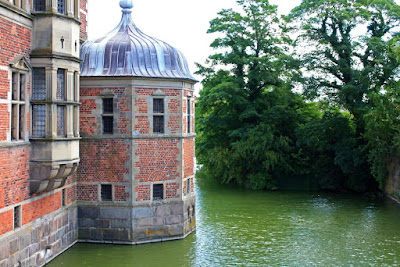The Botanical Garden covers an area of 10 hectares and is particularly noted for its extensive complex of historical glasshouses dating from 1874.
Christiansborg Palace or Christiansborg Castle, on the islet of Slotsholmen in central Copenhagen, is the seat of the Danish Parliament, the Prime Minister's Office and the Supreme Court.
Frederiksborg Palace or Frederiksborg Castle in Hillerød, Denmark, was built as a royal residence for King Christian IV and is now a museum of national history.
Frederiksholms Kanal runs along the south-west side of Slotsholmen, together with Slotholmens Kanal separating the island from Zealand.
The Gefion Fountain on the harbour front in Copenhagen, features a large-scale group of animal figures being driven by the legendary Norse goddess, Gefjun.
The Royal Library Garden, often referred to simply as the Library Garden, is a small, somewhat hidden garden between the Royal Library, the Tøjhus Museum, ChristianIV's Supply Depot and Christiansborg Palace on Slotsholmen in central Copenhagen. It has a reputation for being one of the most tranquil spots in the city centre.
Frederik's Church, popularly known as The Marble Church (Marmorkirken) for its rococo architecture, is an Evangelical Lutheran church. It was designed by the architect Nicolai Eigtved in 1740 and was along with the rest of Frederiksstaden, a district of Copenhagen, intended to commemorate the 300 years jubilee of the first coronation of a member of the House of Oldenburg.
The Little Mermaid is a bronze statue by Edvard Eriksen, depicting a mermaid. The sculpture is displayed on a rock by the waterside at the Langelinie promenade. Based on the fairy tale of the same name by Danish author Hans Christian Andersen, the small and unimposing statue is a Copenhagen icon and has been a major tourist attraction since 1913.
Nyhavn (literally: New Harbour) is a 17th-century waterfront, canal and entertainment district in Copenhagen. It is lined by brightly coloured 17th and early 18th century townhouses and bars, cafes and restaurants. Serving as a "heritage harbour", the canal has many historical wooden ships.
The Copenhagen Opera House is the national opera house of Denmark, and among the most modern opera houses in the world. It is also one of the most expensive opera houses ever built with construction costs well over 500 million U.S. dollars.
Copenhagen City Hall ( Rådhus) is the headquarters of the municipal council as well as the Lord mayor of the Copenhagen Municipality. The building is situated on The City Hall Square in central Copenhagen.
Rosenborg Castle (Danish: Rosenborg Slot) is a renaissance castle located in Copenhagen, Denmark. The castle was originally built as a country summerhouse in 1606 and is an example of Christian IV's many architectural projects. It was built in the Dutch Renaissance style, typical of Danish buildings during this period, and has been expanded several times, finally evolving into its present condition by the year 1624. Architects Bertel Lange and Hans van Steenwinckel the Younger are associated with the structural planning of the castle.
St. Alban's Church, locally often referred to simply as the English Church, is an Anglican church in Copenhagen, Denmark. It was built from 1885 to 1887 for the growing English congregation in the city.
Tivoli Gardens (or simply Tivoli) is a famous amusement park and pleasure garden in Copenhagen, Denmark. The park opened on 15 August 1843 and is the second oldest amusement park in the world, after Dyrehavsbakken in nearby Klampenborg.



























































